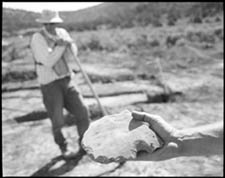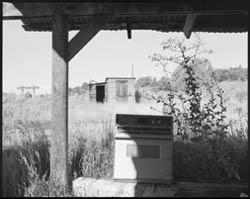|
| Archaeologists in Ridges Basin
work to pump water from a pit house after a good rain. Archaeological
sites in the basin are being excavated and documented in
advance of the Animas-La Plata project, which will dam and
flood the basin with Animas River water./Photo by Ole Bye |
“An artifact is a culturally fashioned item,” says
archaeologist Dr. Jim Potter. And one thing that all artifacts
possess is the potential to offer evidence of human life. A
spent rifle cartridge found in the woods, a sherd of Anasazi
pottery buried under 10 feet of silt or an airplane booming
across the sky: All these can offer up human stories, if you
can read the language.
In Ridges Basin, just 2 miles south of Durango’s busy
downtown, past lives have left traces written in the hard soil,
and archaeologists are now working to interpret those traces
before the waters of the Animas-La Plata Project cover them
for good.
The sites in the basin of the greatest significance date from
the Pueblo I period of the history of the Anasazis, roughly
750 to 900 AD. As excavations continue, a more complete picture
of what the Anasazis might have been doing in the northern reaches
of the San Juan Basin is beginning to emerge.
Sites in Ridges Basin
Many of the 170 identified Pueblo I sites in the basin lie
buried deep in the soil, and it takes a sharp eye to note the
artifacts and the subtle circular depressions that
 |
| A stone tool unearthed in a pit house./Photo
by Ole Bye |
indicate their location. If the site isn’t buried too
deep, sometimes the orange stain of “burnt adobe”
provides a clue. This brick-like substance resulted from the
intentional burning of a structure after occupation. Ironically,
burning also effectively preserves the structure’s basic
features, making burned sites easier to excavate.
When the outline of a pit house is found, a backhoe trench
is dug through the supposed location. If the aim is true, archaeologists
get a cross-section of the dwelling. Then they usually excavate
half of the pit-house, getting a look at the important features
without having to unearth the entire structure.
Habitations in Ridges Basin tend to consist of single, one-room
pit-houses, often with adjacent above-ground storage rooms.
The design of these dwellings is relatively consistent, and
they are usually arranged with a ventilation shaft on the south
side of the room and a low “wing” wall running in
front of the shaft. Firepits are another key feature of these
dwellings, and the carbon found in them allows archaeologists
to accurately date usage. In Ridges Basin, these habitations
are found grouped into small clusters of several dwellings,
suggesting prototype villages.
In addition to the Pueblo I structures are those of the more
primitive and earlier Basketmaker period. Although the simpler
architecture makes the 28 Basketmaker sites less striking, they
are no less valuable. Like the later Puebloans, the Basketmakers
built pit and storage structures, however they didn’t
use ceramics or live in communities. Thus, remains from that
period are much more difficult to find. Sites from the even
earlier Archaic period, of which there are 61 in Ridges Basin,
generally consist of scattered artifacts, since this period
pre-dates permanent structures.
The best preserved archaeological site in Ridges Basin is the
Bodo Ranch, which was last active in the 1970s. After the Bodo
family donated the ranch and most
of Ridges Basin to the Colorado Division of Wildlife, the farm
structures have stood vacant and boarded up. The site consists
of a 100-year-old homestead and a variety of outbuildings and
barns. Like many Ridges Basin archaeological sites, the ranch
sits below the projected water level of the reservoir.
 |
| Mike Lynagh and Mark Lowe
wrap string around the remains of a roof-support post from
an Anasazi pit house. The string will keep the post intact
until it can be dated./Photo by Ole Bye |
Origins and organization
The earliest human signs in Ridges Basin are from the Archaic
period and are estimated to be between 2,000 and 10,000 years
old. Archaic peoples practiced hunting and gathering, and as
a consequence, were typically mobile. Archaeologists recognize
the emergence of the Anasazi as an identifiable group around
500 BC, marking the beginning of the Basketmaker period.
The chief characteristic to denote this change is horticulture.
To domesticate and farm plants, Archaic peoples had to give
up their mobility and build structures for living and storage.
Why hunter-gatherers gave up their mobility and more varied
diet for a stationary life with a limited diet is one of the
great questions of history. “There are certain advantages
to being able to produce a predictable surplus of food to get
you through the winter,” explains Potter. “The risk
is lower, (and) if you’ve got a large enough population,
oftentimes the natural resources can’t support that population.”
It might have been a thousand years after the appearance of
horticulture before the Anasazi moved into Ridges Basin. As
archaeologists uncover more sites in the basin, they’re
convinced that the Anasazi brought horticulture here in the
Pueblo I period. we initially started here, we didn’t
know how big a role agriculture played in their diet,”
Potter says. “Since then, we’ve found so much groundstone
and so much actual corn, burned corn, that it’s really
apparent that corn was a big part of their diet, even at this
early stage.”
The Pueblo I period marks an important jump in sophistication
for the Anasazi, and typical sites have above-ground structures,
adjoining walls and shared walls. This period also marks the
entry into village life for the Anasazi, so sites in Ridges
Basin
 |
An old stove sits among the
outbuildings of the Bodo Ranch, which has been vacant
since the 1970s. /Photo by Ole Bye |
give archaeologists a look at a very significant time period
in Anasazi history. The Animas-La Plata Project Environmental
Impact Statement, prepared by the Bureau of Reclamation, states,
“The 170 Pueblo I sites in the Ridges Basin area provide
an excellent laboratory for addressing questions related to
aggregation, abandonment and mobility.”
One of the most remarkable aspects of the Ridges Basin inhabitation
is that it is believed to have been a multi-ethnic community.
Potter, who oversees the excavations for the contract archaeology
firm SWCA Environmental Consultants, says: “The reason
we think that is we have architecture that is very varied, very
different, in its morphology and construction. In other words,
people are bringing different sorts of traditions, ideas about
how to build a house, with them, suggesting to us that people
are coming from different areas.” If this community were
multi-ethnic, then it is likely to have been multi-lingual,
too. Potter explains, “You have a lot of language groups
in the Southwest, a lot of diversity, and that diversity of
language groups among the Puebloans probably goes back a long
ways.”
The evidence for early, sophisticated village life is what
makes this project an outstanding opportunity, archaeologists
say. “When this is all written up, it’s going to
be so cool, because there’s just not that much Pueblo
I stuff out there, and there’s very little out there from
this area,” says archaeologist Kathy Mowrer.
The scale of the project and the climate both appeal to archaeologists
like Mark Lowe, who notes, “Most parts of the country
don’t get the preservation or the permanent structures.”
Different viewpoints
The Southern Ute and Ute Mountain Ute Indian tribes hired SWCA
to excavate sites in Ridges Basin after the Bureau of Reclamation
appointed the tribes to oversee the management of cultural resources
in the basin. However, the Utes don’t claim
 |
Neal Morris helps survey features
inside of a pit house. |
Anasazi ancestry, and so they consult regularly with the modern
Puebloan tribes of New Mexico that do claim ancestral ties to
the Anasazi. One problem with these consultations is that the
Pueblo tribes are often hesitant to release their proprietary
tribal histories, and so it is hard to say which of the 26 modern
tribes deemed to have affiliation are most closely descended
from the communities of Ridges Basin. So far, the tribes haven’t
objected to the excavations or the manner in which they are
being carried out. “In a sort of roundabout way, they
concur with our findings,” says Terry Knight, Coordinator
of Cultural Resources for the AL-P Project.
The tribal secrecy, Knight explains, is “part of keeping
their identity and their history and ceremonies and social life”
private. Additionally, tribes are sometimes reluctant to announce
their traditional origins in fear of being proven incorrect
by future archaeology. “Once you (claim ancestry), you
open yourself up to criticism and counter claims from the other
Pueblos,” says Knight. So it is understandable that these
tribes are largely staying out of the project and entrusting
the Ute tribes with the excavations. Knight adds, “The
Pueblos said, ‘We don’t want these sites to be disturbed,
but you’re going to have to, so just be careful how you
do it.’”
 |
A sherd of Anasazi pottery,
foreground,
sits on the edge of an excavated pit house while archaeologist
VerneHensler tries to bail water out. |
Another cultural consideration of the Ridges Basin excavations,
as in any project of this nature, is the general aversion to
archaeology among American Indians. “It’s something
we don’t want to do, but has to be done,” admits
Knight. The primary benefit of archaeology to modern native
peoples, he says, is the validation of territorial claims.
Archaeology in the face of A-LP
The reservoir will “disturb and/or destroy” between
80 and 90 archaeological sites, according to the Environmental
Impact Statement, as a direct result of its construction and
filling. Many more sites stand in the way of pipelines, dam
construction and future infrastructure. According to the EIS
estimates, the entire A-LP project, including the Navajo Nation
Municipal Pipeline, will impact 639 “cultural resource
sites.” Additionally, future recreational activities in
Ridges Basin are cause for concern. “Damage to sites could
occur in the form of off-road vehicle use on cultural resources
sites, vandalism or erosion from tertiary roads or trails,”
the EIS states.
 |
Archaeologist Jean Conlan
looks for clues of Anasazi occupation in the cross section
of a pit
house./Photos by Ole Bye |
Before the projected 2008 reservoir fill date, archaeologists
will collect as much information as they can about the Puebloans
who lived here 1,300 years ago. As the evidence of village life
builds, other questions arise. How were the various clusters
of dwellings integrated into a community? Was there a central
cultural or spiritual site? Which dwellings were contemporary
to each other? And how was the basin occupied chronologically?
Before these and many other questions can be answered, more
sites need to be excavated, and more artifacts need to be uncovered
and analyzed; more time needs to be taken. In the next four
years, SWCA, the Utes, and perhaps, the modern Puebloans, hope
to discover the story of life in Ridges Basin that, for certain,
has passed.

